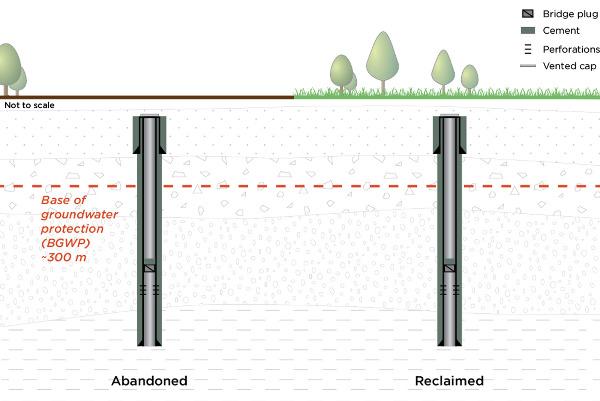When a company no longer needs a well to support its oil and gas development, the well must be permanently sealed and taken out of service. This part of the closure process is known as abandonment.
After decades of energy development in Alberta, abandoned wells are common in the province. About 170 000 abandoned wells exist in Alberta, representing 37 per cent of all wells in the province. However, even after wells are abandoned, they remain the responsibility of the company that owns them.
How a Well Is Abandoned
Before a well can be abandoned, the company that owns the well must
- inform all affected landowners about the proposed abandonment;
- test the well to ensure that it will not pose any risk to the public or the environment once it is abandoned; and
- follow our requirements to make any necessary modifications if issues are found during the well test.
Companies must follow our strict requirements, primarily set out in Directive 020: Well Abandonment, to ensure that the public and environment are protected before, during, and after a well is abandoned. In general, the following stages must be completed.
- Project Planning
The company must design an abandonment program to identify any issues within the well that could lead to potential leaks (e.g., cracks) and to identify all oil or gas formations and all groundwater zones that the well passes through. The company must also evaluate the cement that holds the well in place to ensure that it remains strong and intact.
- Subsurface Abandonment
Next, the company must clean the inside of the wellbore to remove any oil or gas that could cause it to corrode or could cause the cement plugs that will be inserted into the well to leak. Any issues identified with the wellbore during the planning phase must be repaired. In addition, all oil or gas formations must be isolated from one another with cement plugs, and any groundwater zones must be isolated from the wellbore to make sure that no oil, gas, or water can travel up the wellbore and contaminate soil or groundwater. The company must then fill the well with fresh water or other noncorrosive fluid and assess the well to ensure there are no leaks.
- Surface Abandonment
The final step in the abandonment process is known as the “cut-and-cap” stage. The company must cut the well casing to a minimum of one metre below the surface (with some exceptions, which are listed in Directive 020), and place a vented cap atop the well casing. Surface infrastructure associated with the well must be removed within 12 months of completing this stage.

Distance Requirements
We’ve worked extensively with Alberta Municipal Affairs to establish requirements for how far a development like a home or other building can be safely located from an abandoned well. This distance is known as a “setback.” Its purpose is to provide a buffer zone between the public and the well if a problem arises.
Learn more about setbacks in our EnerFAQs Explaining AER Setbacks.
Potential Risks
Given our strict requirements in Directive 020, abandoned wells are expected to pose little risk to the surrounding public or environment. However, risks, such as well leaks, are possible.
A well leak can be caused by many things, such as corrosion, improper abandonment, and damage during digging for other purposes.
If a leak occurs, the company must
- notify us immediately,
- submit a plan that details how the well will be repaired to stop the leak and how any impact to the environment will be managed, and
- repair the well to stop the leak as soon as possible.
Companies must conduct regular gas detection tests to identify leaks and report all results to us. If a company finds a leak, it must meet with us and any landowners to discuss how it will monitor or repair the leak.
Next Steps
After a well is abandoned, the land around it must be returned to its original state. Learn more about this process, known as reclamation, and what we expect from companies during this process.
Sharing Information
We publish abandoned well information, including well locations, on our interactive Abandoned Well Map. This map is available through our Maps page.


